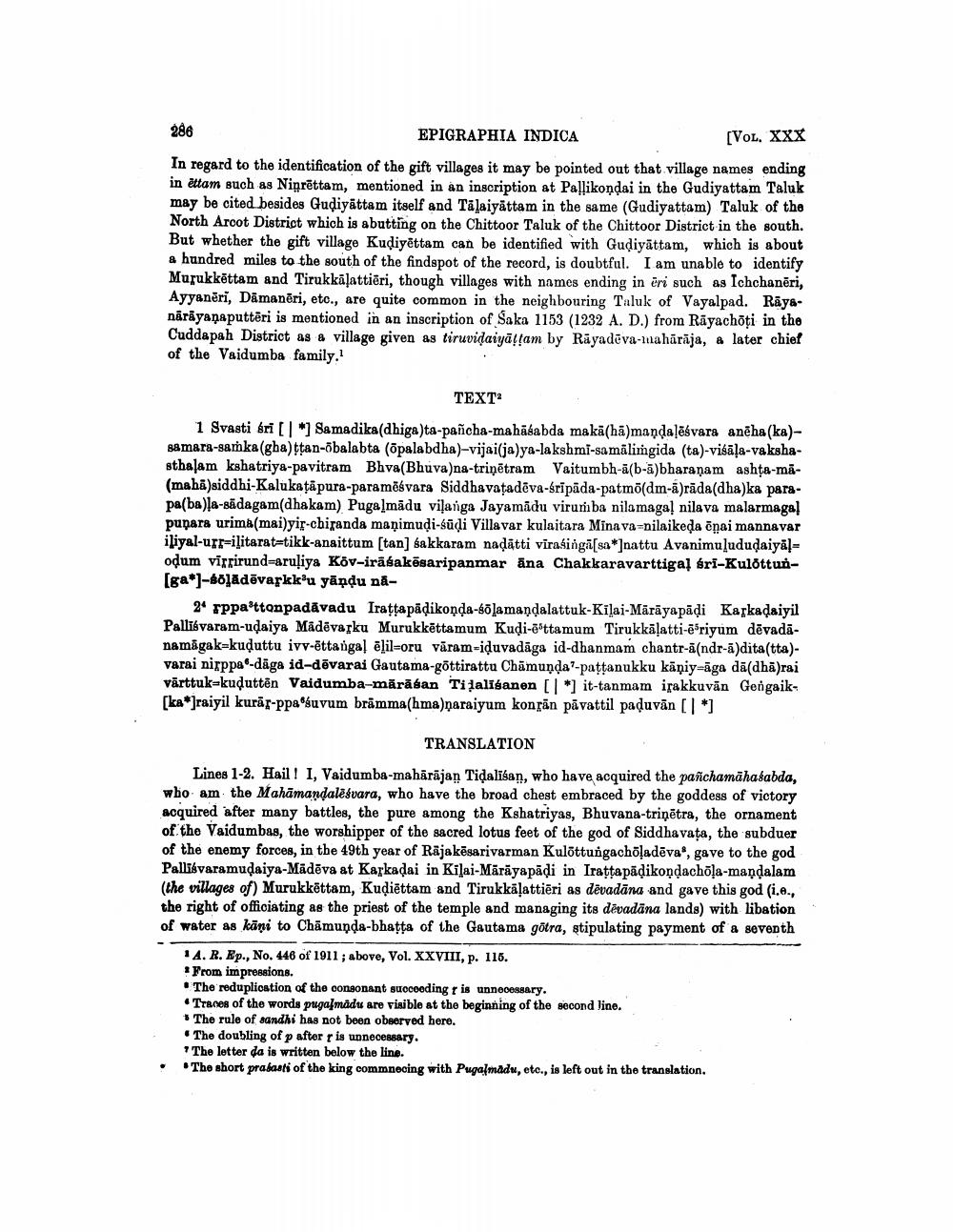________________
286 EPIGRAPHIA INDICA
[VOL. XXX In regard to the identification of the gift villages it may be pointed out that village names ending in attam such as Niņrēttam, mentioned in an inscription at Pallikondai in the Gudiyattam Taluk may be cited besides Gudiyattam itself and Tālaiyattam in the same (Gudiyattam) Taluk of the North Arcot District which is abutting on the Chittoor Taluk of the Chittoor District in the south. But whether the gift village Kudiyőttam can be identified with Gudiyattam, which is about a hundred miles to the south of the findspot of the record, is doubtful. I am unable to identify Murukkottam and Tirukkāļattiēri, though villages with names ending in ēri such as Ichchanēri, Ayyanëri, Dāmanēri, etc., are quite common in the neighbouring Taluk of Vayalpad. Raya. nārāyaṇaputtēri is mentioned in an inscription of Saka 1153 (1232 A. D.) from Rāyachoţi in the Cuddapah District as a village given as tiruvidaiyā tam by Rayadeva-wuahārāja, a later chief of the Vaidumba family.
TEXT
1 Svasti eri [] *) Samadika (dhiga)ta-pancha-mahāśabda makā(hā)mandalēśvara anēha (ka)samara-samka(gha)ttan-7balabta (õpalabdha)-vijai(ja)ya-lakshmi-samälimgida (ta)-visāļa-vakshasthalam kshatriya-pavitram Bhva(Bhuva)na-triņētram Vaitumbh-ā(b-a)bharaṇam ashta-ma(mahā)siddhi-Kalukatāpura-paramēsvara Siddhavațadēva-trīpāda-patmõ(dm-ā)rāda (dha)ka parapa(ba)]a-sādagam(dhakam) Pugalmādu vilanga Jayamādu virumba nila magal nilava malarmagal punara urima(mai)yir-chiranda manimudi-sūdi Villavar kulaitara Minava-nilaikeda ēnai mannavar iliyal-urr-ilitarat-tikk-anaittum (tan) sakkaram nadātti virasinga[sa *]nattu Avanimulududaiyāļ= odum virgirund-aruļiya Kov-irāśakēsaripanmar äna Chakkaravarttigal sri-Kulottun[ga*]-66]ādēvarkk'u yāņdu nā
24 Fppa'ttonpadāvadu Irattapädikonda-6ālamandalattuk-Kilai-Mārāyapāļi Kaçkadaiyil Pallīśvaram-udaiya Mädēvasku Murukkēttamum Kudi-'ttamum Tirukkälatti-e'riyum dēvadānamāgak-kuduttu ivv-éttangalēļil-oru vāram-iduvadāga id-dhanmam chantr-a(ndr-a)dita(tta)varai nirppa-däga id-dēvarai Gautama-göttirattu Chāmunda’-pattanukku kāņiy=āga dā(dhā)rai Värttuk-kuduttēn Vaidumba-mārāsan Tilaliganen []*] it-tanmam ipakkuvan Gengaiks [ka*]raiyil kurās-ppasuvum brāmma(hma)ņaraiyum kongān pāvattil paduvān (*]
TRANSLATION
Lines 1-2. Hail! I, Vaidumba-mahārājan Tidalīšan, who have acquired the panchamāhasabda, who am the Mahāmandalēsvara, who have the broad chest embraced by the goddess of victory acquired after many battles, the pure among the Kshatriyas, Bhuvana-trinētra, the ornament of the Vaidumbas, the worshipper of the sacred lotus feet of the god of Siddhavata, the subduer of the enemy forces, in the 49th year of Räjakēsarivarman Kulöttungachöļadēva", gave to the god Pallisvaramudaiya-Mädēva at Karkadai in Kilai-Mārāyapādi in Irattapädikondachõļa-mandalam (the villages of) Murukkēttam, Kudiēttam and Tirukkāļattiēri as dēvadāna and gave this god (i..., the right of officiating as the priest of the temple and managing its dévadāna lands) with libation of water as kāni to Chamunda-bhatta of the Gautama götra, stipulating payment of a seventh
14. R. Ep., No. 448 of 1911; above, Vol. XXVIII, p. 116. ? From impressions. • The reduplication of the consonant suoceeding r is unnecessary. • Traces of the words puga madu are visible at the beginning of the second line. The rule of sandhi has not been observed here. The doubling of p after r is unnecessary. * The letter da is written below the line. .The short prasasti of the king commnecing with Pugalmado, etc., is left out in the translation.




